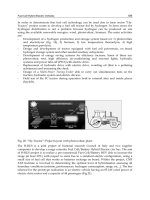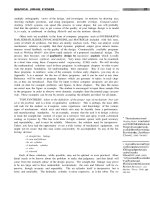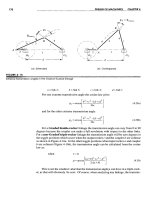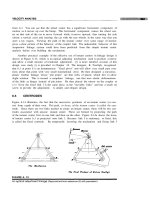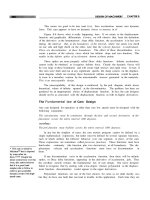DESIGN OF MACHINERYAN INTRODUCTION TO THE SYNTHESIS AND ANALYSIS OF MECHANISMS AND MACHINES phần 7 potx
Bạn đang xem bản rút gọn của tài liệu. Xem và tải ngay bản đầy đủ của tài liệu tại đây (4.24 MB, 93 trang )
11.11
CONTROLLING INPUT TORQUE-flYWHEElS
The typically large variation in accelerations within a mechanism can cause significant
oscillations in the torque required to drive it at a constant or near constant speed. The
peak torques needed may be so high as to require an overly large motor to deliver them.
However, the average torque over the cycle, due mainly to losses and external work done,
may often be much smaller than the peak torque. We would like to provide some means
to smooth out these oscillations in torque during the cycle. This will allow us to size the
motor to deliver the average torque rather than the peak torque. One convenient and rel-
atively inexpensive means to this end is the addition of a flywheel to the system.
TORQUE VARIATION
Figure 11-8 shows the variation in the input torque for a
crank-rocker fourbar linkage over one full revolution of the drive crank. It is running at
a constant angular velocity of 50 rad/sec. The torque varies a great deal within one cy-
cle of the mechanism, going from a positive peak of 341.7 Ib-in to a negative peak of
-166.41b-in. The average value of this torque over the cycle is only 70.21b-in, being
due to the external work done plus losses. This linkage has only a 12-lb external force
applied to link 3 at the CG and a 25 Ib-in external torque applied to link 4. These small
external loads cannot account for the large variation in input torque required to maintain
constant crank speed. What then is the explanation? The large variations in torque are
evidence of the kinetic energy that is stored in the links as they move. We can think of
the positive pulses of torque as representing energy delivered by the driver (motor) and
stored temporarily in the moving links, and the negative pulses of torque as energy at-
tempting to return from the links to the driver. Unfortunately most motors are designed
to deliver energy but not to take it back. Thus the "returned energy" has no place to go.
Figure 11-9 shows the speed torque characteristic of a permanent magnet (PM) DC
electric motor. Other types of motors will have differently shaped functions that relate
motor speed to torque as shown in Figure 2-32 and 2-33 (pp. 62-63), but all drivers
below that line.) The integration limits in equation 11.18 are from the shaft angle 8 at which
the shaft (j)is a minimum to the shaft angle 8 at which (j)is a maximum.
3
The minimum (j)will occur after the maximum positive energy has been delivered from the
motor to the load, i.e., at a point (8) where the summation of positive energy (area) in the
torque pulses is at its largest positive value.
4
The maximum (j)will occur after the maximum negative energy has been returned to the load,
i.e., at a point (8) where the summation of energy (area) in the torque pulses is at its largest
negative value.
5
To find these locations in 8 corresponding to the maximum and minimum (j)'s and thus find
the amount of energy needed to be stored in the flywheel, we need to numerically integrate
each pulse of this function from crossover to crossover with the average line. The crossover
points in Figure 11-11 have been labeled A, B, C, and D. (Program FOURBARdoes this inte-
gration for you numerically, using a trapezoidal rule.)
6
The FOURBARprogram prints the table of areas shown in Figure 11-11. The positive and
negative pulses are separately integrated as described above. Reference to the plot of the
torque function will indicate whether a positive or negative pulse is the first encountered in
a particular case. The first pulse in this example is a positive one.
7
The remaining task is to accumulate these pulse areas beginning at an arbitrary crossover (in
this case point A) and proceeding pulse by pulse across the cycle. Table 11-1 shows this pro-
cess and the result.
8
Note in Table 11-1 that the minimum shaft speed occurs after the largest accumulated posi-
tive energy pulse (+200.73 in-lb) has been delivered from the driveshaft to the system. This
delivery of energy slows the motor down. The maximum shaft speed occurs after the largest
accumulated negative energy pulse (-60.32 in-lb) has been received back from the system
by the driveshaft. This return of stored energy will speed up the motor. The total energy
variation is the algebraic difference between these two extreme values, which in this exam-
ple is -261.05 in-lb. This negative energy coming out of the system needs to be absorbed by
the flywheel and then returned to the system during each cycle to smooth the variations in
shaft speed.
(i)
to compute the needed
system
Is.
The physical flywheel's mass moment of inertia
If
is then set equal to the re-
quired system
Is.
But if the moments of inertia of the other rotating elements on the same
driveshaft (such as the motor) are known, the physical flywheel's required
If
can be re-
duced by those amounts.
The most efficient flywheel design in terms of maximizing
Iffor
minimum material
used is one in which the mass is concentrated in its rim and its hub is supported on
spokes, like a carriage wheel. This puts the majority of the mass at the largest radius
possible and minimizes the weight for a given
If
Even if a flat, solid circular disk fly-
wheel design is chosen, either for simplicity of manufacture or to obtain a flat surface
for other functions (such as an automobile clutch), the design should be done with an eye
to reducing weight and thus cost. Since in general,
I
=
m,.2,
a thin disk of large diame-
ter will need fewer pounds of material to obtain a given
I
than will a thicker disk of small-
er diameter. Dense materials such as cast iron and steel are the obvious choices for a fly-
wheel. Aluminum is seldom used. Though many metals (lead, gold, silver, platinum) are
more dense than iron and steel, one can seldom get the accounting department's approv-
al to use them in a flywheel.
Figure 11-12 shows the change in the input torque T
1
2 for the linkage in Figure 11-8
after the addition of a flywheel sized to provide a coefficient of fluctuation of 0.05. The
oscillation in torque about the unchanged average value is now 5%, much less than what
it was without the flywheel. A much smaller horsepower motor can now be used because
the flywheel is available to absorb the energy returned from the linkage during its cycle.
11.12
A LINKAGE FORCE TRANSMISSION INDEX
The transmission angle was introduced in Chapter 2 and used in subsequent chapters as
an index of merit to predict the kinematic behavior of a linkage. A too-small transmis-
sion angle predicts problems with motion and force transmission in a fourbar linkage.
Unfortunately, the transmission angle has limited application. It is only useful for four-
bar linkages and then only when the input and output torques are applied to links that are
pivoted to ground (i.e., the crank and rocker). When external forces are applied to the
coupler link, the transmission angle tells nothing about the linkage's behavior.
Holte and Chase
[1]
define a joint-force index
(IPl)
which is useful as an indicator
of any linkage's ability to smoothly transmit energy regardless of where the loads are
applied on the linkage. It is applicable to higher-order linkages as well as to the fourbar
linkage. The IPI at any instantaneous position is defined as the ratio of the maximum
static force in any joint of the mechanism to the applied external load. If the external
load is a force, then it is:
The F
ij
are calculated from a static force analysis of the linkage. Dynamic forces
can be much greater than static forces if speeds are high. However, if this static force
transmission index indicates a problem in the absence of any dynamic forces, then the
situation will obviously be worse at speed. The largest joint force at each position is used
rather than a composite or average value on the assumption that high friction in anyone
joint is sufficient to hamper linkage performance regardless of the forces at other joints.
Equation 11.23a is dimensionless and so can be used to compare linkages of differ-
ent design and geometry. Equation 11.23b has dimensions of reciprocal length, so cau-
tion must be exercised when comparing designs when the external load is a torque. Then
the units used in any comparison must be the same, and the compared linkages should
be similar in size.
Equations 11.23 apply to anyone instantaneous position of the linkage. As with the
transmission angle, this index must be evaluated for all positions of the linkage over its
expected range of motion and the largest value of that set found. The peak force may
move from pin to pin as the linkage rotates. If the external loads vary with linkage posi-
tion, they can be accounted for in the calculation.
Holte and Chase suggest that the IPI be kept below a value of about 2 for linkages
whose output is a force. Larger values may be tolerable especially if the joints are de-
signed with good bearings that are able to handle the higher loads.
There are some linkage positions in which the IPI can become infinite or indetermi-
nate as when the linkage reaches an immovable position, defined as the input link or in-
put joint being inactive. This is equivalent to a stationary configuration as described in
earlier chapters provided that the input joint is inactive in the particular stationary con-
figuration. These positions need to be identified and avoided in any event, independent
of the determination of any index of merit. In some cases the mechanism may be im-
movable but still capable of supporting a load. See reference [1] for more detailed infor-
mation on these special cases.
11.13 PRACTICAL CONSIDERATIONS
This chapter has presented some approaches to the computation of dynamic forces in
moving machinery. The newtonian approach gives the most information and is neces-
sary in order to obtain the forces at all pin joints so that stress analyses of the members
can be done. Its application is really quite straightforward, requiring only the creation
of correct free-body diagrams for each member and the application of the two simple
vector equations which express Newton's second law to each free-body. Once these
equations are expanded for each member in the system and placed in standard matrix
form, their solution (with a computer) is a trivial task.
The real work in designing these mechanisms comes in the determination of the
shapes and sizes of the members. In addition to the kinematic data, the force computa-
tion requires only the masses, CG locations, and mass moments of inertia versus those
CGs for its completion. These three geometric parameters completely characterize the
member for dynamic modelling purposes. Even if the link shapes and materials are com-
pletely defined at the outset of the force analysis process (as with the redesign of an ex-
isting system), it is a tedious exercise to calculate the dynamic properties of complicated
shapes. Current solids modelling CAD systems make this step easy by computing these
parameters automatically for any part designed within them.
If, however, you are starting from scratch with your design, the blank-paper syn-
drome will inevitably rear its ugly head. A first approximation of link shapes and selec-
tion of materials must be made in order to create the dynamic parameters needed for a
"first pass" force analysis. A stress analysis of those parts, based on the calculated dy-
namic forces, will invariably find problems that require changes to the part shapes, thus
requiring recalculation of the dynamic properties and recomputation of the dynamic forc-
es and stresses. This process will have to be repeated in circular fashion (iteration-see
Chapter 1, p. 8) until an acceptable design is reached. The advantages of using a com-
puter to do these repetitive calculations is obvious and cannot be overstressed. An equa-
tion solver program such as TKSolver or Mathcad will be a useful aid in this process by
reducing the amount of computer programming necessary.
Students with no design experience are often not sure how to approach this process
of designing parts for dynamic applications. The following suggestions are offered to
get you started. As you gain experience, you will develop your own approach.
It is often useful to create complex shapes from a combination of simple shapes, at
least for first approximation dynamic models. For example, a link could be considered
to be made up of a hollow cylinder at each pivot end, connected by a rectangular prism
along the line of centers. It is easy to calculate the dynamic parameters for each of these
simple shapes and then combine them. The steps would be as follows (repeated for each
link):
1 Calculate the volume, mass, CG location, and mass moments of inertia with respect
to the local CG of each separate part of your built-up link. In our example link these
parts would be the two hollow cylinders and the rectangular prism.
2 Find the location of the composite CG of the assembly of the parts into the link by
the method shown in Section 11.4 (p. 531) and equation 11.3 (p. 524). See also Fig-
ure 11-2 (p. 526).
Z
.
There is a vertical force at P of F
=
500 N. Find all pin forces and the torque
needed to drive the crank at this instant.
*t:J:11-12 Figure PII-5b shows a fourbar linkage and its dimensions in meters. The steel crank,
coupler, and rocker have uniform cross sections of 50 mm diameter. In the instanta-
neous position shown, the crank OzA has
0)
=
-10 rad/sec and
a
=
10 rad/sec
2
.
There
is a horizontal force at P of F
=
300 N. Find all pin forces and the torque needed to
drive the crank at this instant.
*t:J:11-13 Figure PII-6 shows a water jet loom laybar drive mechanism driven by a pair of
Grashof crank rocker fourbar linkages. The crank rotates at 500 rpm. The laybar is
carried between the coupler-rocker joints of the two linkages at their respective
instant centers h,4. The combined weight of the reed and laybar is 29 lb. A 540-lb
beat-up force from the cloth is applied to the reed as shown. The steel links have a 2
X
I in uniform cross section. Find the forces on the pins for one revolution of the
crank. Find the torque-time function required to drive the system.
tll-14 Figure PII-7 shows a crimping tool. Find the force Fhandneeded to generate a 2000-
Ib Fcrimp' Find the pin forces. What is this linkage's joint force transmission index
(IFI) in this position?
t§ 11-15 Figure P 11-8 shows a walking beam conveyor mechanism that operates at slow speed
(25 rpm). The boxes being pushed each weigh 50 lb. Determine the pin forces in the
linkage and the torque required to drive the mechanism through one revolution.
Neglect the masses of the links.
t§ 11-16 Figure PII-9 shows a surface grinder table drive that operates at 120 rpm. The crank
radius is 22 mm, the coupler is 157 mm, and its offset is 40 mm. The mass of table
and workpiece combined is 50 kg. Find the pin forces, slider side loads, and driving
torque over one revolution.
t§1l-17 Figure Pll-1O shows a power hacksaw that operates at 50 rpm. The crank is 75 mm,
the coupler is 170 mm, and its offset is 45 mm. Find the pin forces, slider side loads,
and driving torque over one revolution for a cutting force of 250 N in the forward
direction and 50 N during the return stroke.
t§11-18 Figure Pll-ll shows a paper roll off-loading station. The paper rolls have a 0.9-m
OD, 0.22-m ID, are 3.23 m long, and have a density of 984 kg/m
3
. The forks that
support the roll are 1.2 m long. The motion is slow so inertial loading can be
neglected. Find the force required of the air cylinder to rotate the roll through 90°.
t 11-19 Derive an expression for the relationship between flywheel mass and the dimension-
less parameter radius/thickness
(r/t)
for a solid disk flywheel of moment of inertia
f.
Plot this function for an arbitrary value of
f
and determine the optimum r/t ratio to
minimize flywheel weight for that
f.
These larger-scale project statements deliberately lack detail and structure and are
loosely defined. Thus, they are similar to the kind of "identification of need " or problem
statement commonly encountered in engineering practice. It is left to the student to struc-
ture the problem through background research and to create a clear goal statement and
set of performance specifications before attempting to design a solution. This design
process is spelled out in Chapter 1 and should befollowed in all of these examples. All
results should be documented in a professional engineering report. See the Bibliogra-
phy in Chapter 1for references on report writing.
Some of these project problems are based on the kinematic design projects in Chap-
ter 3. Those kinematic devices can now be designed more realistically with consideration
of the dynamic forces that they generate. The strategy in most of the following project
problems is to keep the dynamic pin forces and thus the shaking forces to a minimum and
also keep the input torque-time curve as smooth as possible to minimize power require-
ments. All these problems can be solved with a pin-jointed fourbar linkage. Thisfact
will allow you to use program FOURBAR to do the kinematic and dynamic computations
on a large number and variety of designs in a short time. There are infinities of viable
solutions to these problems. Iterate to find the best one! All links must be designed in
detail as to their geometry (mass, moment of inertia, etc.). An equation solver such as
Mathcad or TKSolver will be useful here. Determine all pin forces, shaking force, shak-
ing torque, and input horsepower required for your designs.
Pll-l Project P3-1 stated that:
The tennis coach needs a better tennis ball server for practice. This device must fire a
sequence of standard tennis balls from one side of a standard tennis court over the net
such that they land and bounce within each of the three court areas defined by the
court's white lines. The order and frequency of a ball's landing in anyone of the
three court areas must be random. The device should operate automatically and
unattended except for the refill of balls. It should be capable of firing 50 balls
between reloads. The timing of ball releases should vary. For simplicity, a motor-
driven pin-jointed linkage design is preferred.
This project asks you to design such a device to be mounted upon a tripod stand of
5-foot height. Design it, and the stand, for stability against tipover due to the shaking
forces and shaking torques which should also be minimized in the design of your
linkage. Minimize the input torque required.
PII-2 Project P3-9 stated that:
The "Save the Skeet" foundation has requested a more humane skeet launcher be
designed. While they have not yet succeeded in passing legislation to prevent the
wholesale slaughter of these little devils, they are concerned about the inhumane
aspects of the large accelerations imparted to the skeet as it is launched into the sky
for the sportsperson to shoot it down. The need is for a skeet launcher that will
smoothly accelerate the clay pigeon onto its desired trajectory.


